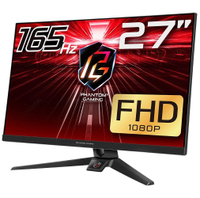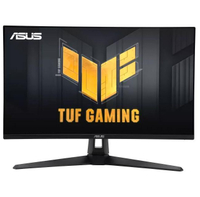Starting at just $120 these are the two best cheap gaming monitors I'd buy myself right now
27-inch 1080p IPS for $120 or 27-inch 1440p VA for $60 more—it's great to have this kind of choice over gaming screens.

ASRock Phantom Gaming | 27-inch | 1080p | 165Hz | IPS | FreeSync | $179.99 $119.99 at Newegg (save $60)
We love a simple but great 1080p monitor, and this ASRock is one of our favorite choices for gaming screen deals. There's nothing to complain about here when you're getting a big, fast IPS panel for just under $120.
Price check: Amazon $159.99
Asus TUF Gaming VG27AQA1A | 27-inch | 1440p | VA | $179.99 at Newegg
If 1080p isn't a high enough resolution for you, then how about spending just $60 more for 78% extra pixels? That VA panel is big and bold, with lots of contrast, and all for very little money.
Price check: Amazon $299.89
A good monitor will last you many years but that doesn't mean you have to spend a small fortune on getting the largest OLED display you can get. Pick the right budget gaming monitor and you'll have a screen that will be more than good enough for nearly every PC gamer.
One of the best cheap gaming monitors I'd buy myself is the ASRock Phantom Gaming PG27FF1A for just $120 at Newegg. It has a 27-inch IPS panel, with a resolution of 1080p and a maximum refresh rate of 165 Hz. There's even support for FreeSync Premium variable refresh rate, to ensure smooth, tear-free gaming.
Tucked underneath the panel's edge are two HDMI 2.0 ports, one DisplayPort 1.2, and a 3.5 mm headset socket. While those aren't the latest versions, they're more than good enough for 1080p 165 Hz.
To keep the price low, ASRock has cut out some features, though, with the most notable being the lack of height adjustment in the stand. You've got a fair amount of tilt and swivel on offer, but you'll need to stack it on a box or two, if you need to raise it up.
At 27-inches, the screen is somewhat on the large side for 1080p gaming and the low pixel density will be quite obvious if you sit close to the screen. Oh, and you can forget about using HDR, despite the claim it supports HDR10. Technically it does but as that's the bare minimum, it's not very good—just leave it in standard mode (SDR) and enjoy its natural colors and brightness.
For a cent under $120, though, you can forgive ASRock for those minor quibbles. You're getting a really nice gaming monitor for the money.
Mainstream graphics cards are more than capable of pushing more than 1080p at decent frame rates, so if you're looking for a higher resolution monitor, but don't want to spend lots of money, then this Asus TUF Gaming VG27AQA1A (that's a lot of As) for $180 at Newegg is the one to get.
It has a 27-inch screen like the ASRock model, but this one uses a VA display. That means the viewing angles aren't as good and the color reproduction is a little down on specs, but what you get in return is a fast response, bright colors, and an excellent contrast ratio. IPS fans might turn their noses up at a VA panel, but they do handle black colors and contrast far better.
The refresh rate is slightly overclocked to 170 Hz, though it does support slower rates if you don't like how it looks running at that speed. There's FreeSync Premium support with this monitor too and like the ASRock, there's HDR10 support on offer (though again you still won't want to use it).
Its stand is very basic—no height or tilt adjustment, only swivel—but that's about it for negatives. There are two HDMI 2.0, one DP v1.2, and a headset socket just as with the ASRock monitor.
The extra $60 you'd spend on buying this over the Phantom Gaming screen gets you 78% more pixels, so the pixel density is much better. Perfect if you like sitting close to your monitor during gaming.
Both displays are well worth the asking prices if you ask me and, for once, it's nice to have a choice where you really can't go wrong, no matter which one you pick.
The biggest gaming news, reviews and hardware deals
Keep up to date with the most important stories and the best deals, as picked by the PC Gamer team.

Nick, gaming, and computers all first met in 1981, with the love affair starting on a Sinclair ZX81 in kit form and a book on ZX Basic. He ended up becoming a physics and IT teacher, but by the late 1990s decided it was time to cut his teeth writing for a long defunct UK tech site. He went on to do the same at Madonion, helping to write the help files for 3DMark and PCMark. After a short stint working at Beyond3D.com, Nick joined Futuremark (MadOnion rebranded) full-time, as editor-in-chief for its gaming and hardware section, YouGamers. After the site shutdown, he became an engineering and computing lecturer for many years, but missed the writing bug. Cue four years at TechSpot.com and over 100 long articles on anything and everything. He freely admits to being far too obsessed with GPUs and open world grindy RPGs, but who isn't these days?



